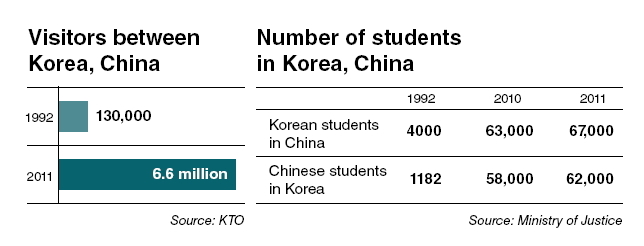This is the sixth and last in a series of articles to mark the 20th anniversary of diplomatic ties between South Korea and China. ― Ed.
The term “hallyu” was first coined in the late 1990s by Chinese journalists to describe Chinese people’s craze over Korean TV dramas. Hallyu, meaning Korean Wave, has continued for more than ten years and has sparked China’s interest in other Korean cultural content and business industries such as Korean products, food, tourism, medical services and even the Korean language.
K-pop further boosted the Korean Wave in China. Korean pop stars are stepping into the Chinese limelight every year. Tickets for their concerts have sold out, and the number of Chinese fans at online fan clubs has dramatically increased, proving their star power.
The widespread interest in Korean modern culture in China is likely to continue. The positive image of Korea built on good-looking stars could contribute to strengthening ties between the two countries despite ongoing political and business disputes.
However, experts say that the lack of exchanges of other high-quality cultural content such as literature, fine arts and theatrical performances will hinder the two countries from building deeper understanding in the future. The one-way Korean wave is also a problem, they added.
“The continuing Korean Wave in China means that China has somehow accepted Korean culture. But Korea didn’t open as much as China did in the past years,” said Ryoo Jae-ki, chairman of Korea-China Culture and Art Forum.
“The cultural exchange should first accompany a mutual understanding of the two cultures. Koreans, too, should be ready to appreciate a wide range of Chinese culture and arts. Therefore, we need to have various cultural exchange programs and forums freely organized at a non-governmental level,” he told The Korea Herald.
Korea and China have focused on building business partnerships since the two established diplomatic ties in 1992. But the cultural exchange between the two countries will play a pivotal role in the future.
“Cultural exchanges will become the center of diplomatic ties between Korea and China in the next 20 years,” said Gyeonggi Governor Kim Moon-soo at a recent conference in Seoul.
Noting that the Chinese government is making massive investments to develop the country’s cultural sector, Kim said this will offer new opportunities for Korean content developers.
“The Chinese government aims to expand the volume of its culture-related industry in gross domestic product from 2.8 percent to 5 percent by the year 2015. The government will likely benchmark the successful case of Korea’s culture industry which has been exporting hallyu-related products overseas. It will open more doors for Korean content developers as well,” he said.
Ryoo agreed. “Exchange of culture and arts between Korea and China will accelerate in the future and this will contribute highly to the two countries building strong ties,” said the former director of Korea Cultural Center in China.
China sees a growing demand for culture, entertainment and arts. This has led its government to spent $4.8 billion alone to construct modern theaters in 20 major cities around the country over last two or three years.
“This will offer opportunities for Korean artists and theater groups to introduce high-quality cultural content, not just Korean pop culture,” he said.
Experts also noted that the two countries could collaborate in content development such as making films, dramas and theater productions together. Song Seung-hwan, chairman of PMC production, for instance, is trying to open an exclusive theater for his nonverbal performance in Beijing while other directors are in talks with Chinese investors for making films.
“We have established a joint stock company in China. This will lead us to seek a bigger market together,” Song said in a recent interview.
Korea-China tourism
The interests in entertainment and culture have brought millions of Chinese visitors in Korea.

According to the Korea Tourism Organization, the number of Chinese travelers to Korea from January to July this year surged 22 percent from the same period last year to 6.35 million. Tourist sites in Seoul are now filled with Chinese visitors, outnumbering the presence of Japanese visitors who used to the biggest foreign tourist group.
Last month, the number of Chinese visitors to Korea was 320,000 of the total 1.2 million, topping the list of foreign travelers in Korea for the first time.
Not only interests in Korean culture but also easier entry for Chinese travelers to Korea have helped Korea attract more visitors from the neighboring country, officials said. Requirements for acquiring tourist visas have been simplified and services at immigration services are improved to offer convenience to Chinese travelers, they added.
The number of Korean students in China as well as Chinese students in Korea also increased, reflecting rapid progress in the exchange of human resources. About 100 universities in Korea and China have been promoting educational exchanges so far.
Korean students account for 62,400 or 21 percent of foreign students in China, according to recent data. There are more than 30 universities in China that operate Korean studies, it added.
By Cho Chung-un (
christory@heraldcorp.com)








![[Today’s K-pop] Blackpink’s Jennie, Lisa invited to Coachella as solo acts](http://res.heraldm.com/phpwas/restmb_idxmake.php?idx=644&simg=/content/image/2024/11/21/20241121050099_0.jpg)